Show type Touring production Director Jocelyn Barnabé | Director of creation Line Tremblay Initial release 2006 Editor Sylvain Lebel | |
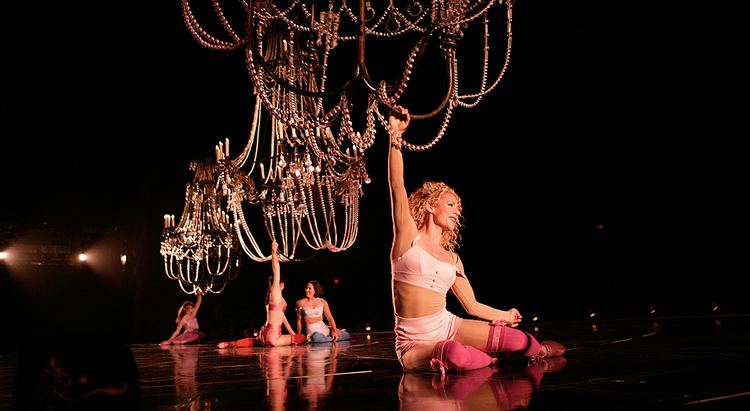 | ||
Cast Mauro Mozzani, Igor Issakov Awards Primetime Emmy Award for Outstanding Film Editing - Special Nominations Primetime Emmy Award for Outstanding Art Direction for Variety, Music or Nonfiction Programming Similar Dralion, Cirque du Soleil: Worlds A, Fakers, The Last Casino, Le Grand Tour Profiles | ||
Spot rtl corteo 2006
Corteo /kɔːrˈteɪ.oʊ/ was a Cirque du Soleil touring production that premiered in Montreal, Canada on April 21, 2005. As of May 24, 2005, Cirque du Soleil had broken its record of spectators for the première location in Montreal; more than 200,000 people had viewed the production, far outpacing the prior record of 180,000 tickets sold for Varekai during its première. The show's final performance took place in Quito, Ecuador on 13 December 2015.
Contents
- Spot rtl corteo 2006
- Corteo 2005 2006
- Set and technical information
- Cast
- Acts
- Rotative Acts
- Retired acts
- Costumes
- Music
- Filmography
- Tour
- Reception
- References
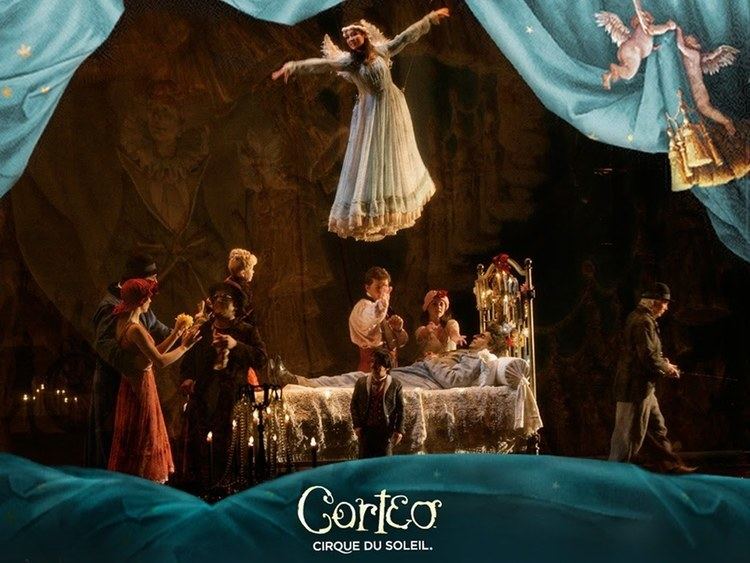
Cortéo—an Italian word meaning "cortège" or procession—was a contemporary circus show about a clown who watches his own funeral taking place in a carnival-like atmosphere. It was partly inspired by The Grand Parade: Portrait of the Artist as Clown on display at the National Gallery of Canada.
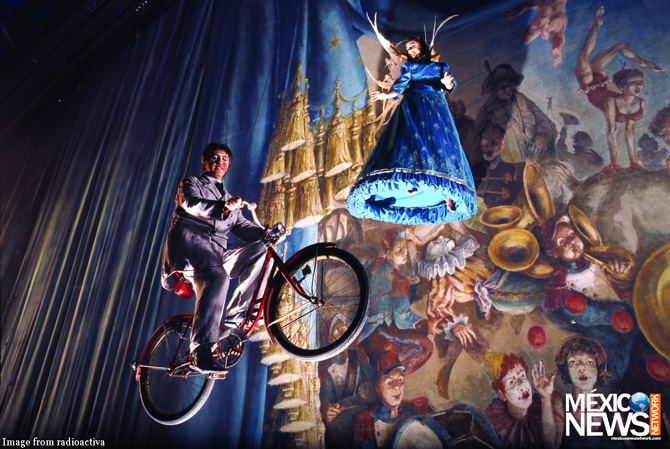
Directed by Daniele Finzi Pasca, founder of the Swiss clown troupe Teatro Sunil and director of several shows by Cirque Éloize, Cortéo was presented in the round under a large tent. The action took place on a large circular stage consisting of concentric rotating rings. This allowed one area of the stage to rotate while another remained stationary. At times during the performance, the stage was divided by a large curtain illustrated with a painting called the Cortéo Procession. There were entrances/exits at either side of the circular stage.
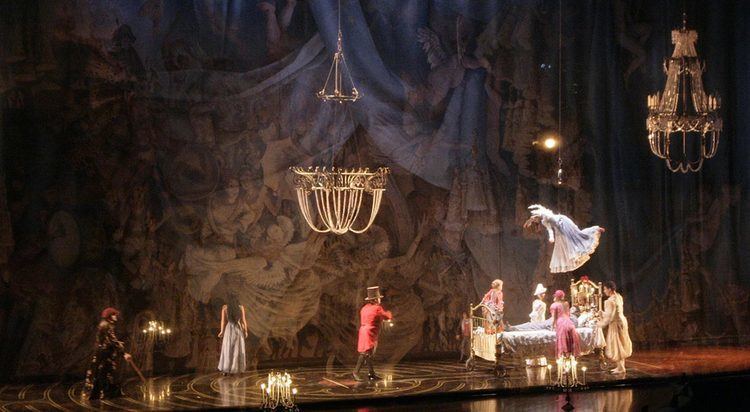
Corteo 2005 2006
Set and technical information
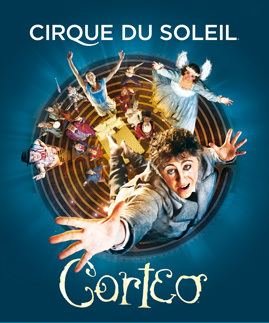
During its big top tour, Cirque du Soleil divided the Grand Chapiteau in two by creating a stage that spanned the diameter of the tent, thus allowing the audience to face one another as well as giving a performer's perspective to them. Built into the 104 feet (32 m) long stage were two turntables with a diameter of 41 feet (12 m). Corteo's set had a special overhead transport mechanism, dubbed the "Patience", which had two rails fitted with four platform-like carts each. Each cart had a lifting capacity of 1,000 pounds (450 kg) and a top speed of 4 feet per second (1.2 m/s). At its highest point, it was 41 feet (12 m) above the stage.

The curtains utilized in Corteo were painted in watercolors and were inspired by a painting from 1885 by Adolphe Willette. The Roll Drop curtains were about 58 feet (18 m) in width and 40 feet (12 m) in height. The inner curtains were constructed in Canada and sent to France to be painted. Each of the four inner curtains took nearly two weeks to be individually painted.

The design on the center stage was a labyrinth which exactly matches the proportions and size of the one on the floor of Chartres Cathedral.
Cast
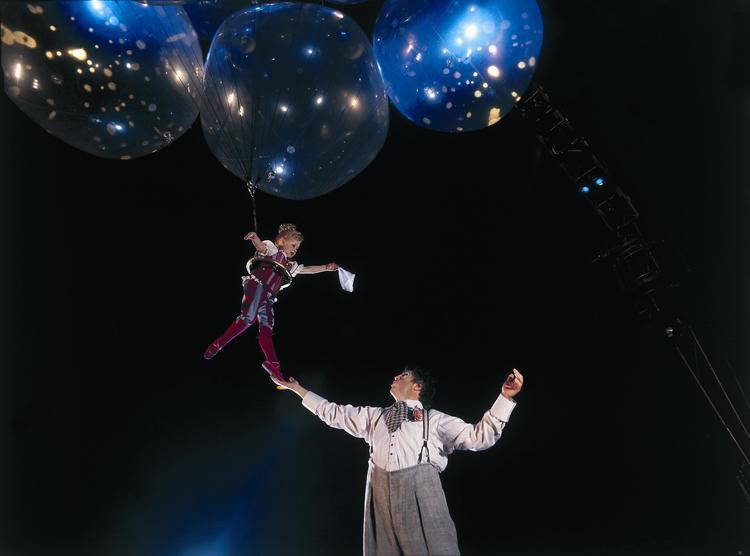
The principal characters of Corteo were clowns, as is fitting for a clown's funeral, but 62 artists comprised the full troupe.
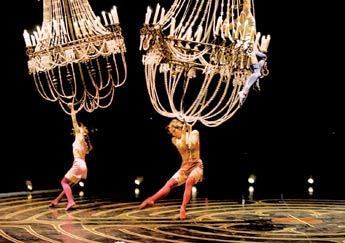
Acts
The acts in Corteo brought together the passion of acting with the grace and power of acrobatics.
Rotative Acts
Retired acts
Costumes
Corteo's costume designer, Dominique Lemieux, utilized "matériaux bruts et des matières nobles" (French for "raw and luxury fabrics") to create a wardrobe that accentuated the artists' natural beauty. The finer details of the outfits were inspired by European styles between 1890 and 1930. The color palette chosen was soft in nature, including blue, pink, and fuchsia along with copper and gold hues. In order to create a worn-in, hand-me-down style of clothing, the costumes were airbrushed and dyed. Common fabrics throughout the wardrobe included silk, linen, and cotton, which were adorned with beaded lace, sequins, and gemstones. In total, more than 900 fabrics were utilized to create the 184 costumes. If back-up and rotational costumes are to be taken into account, the total costume count was around 450 costumes with 284 rotations. During each show day, 12 to 16 hours of ironing was necessary to prepare the costumes.
Music
Corteo’s score was originally composed by Philippe Leduc and Maria Bonzanigo. Additional composers including Jean-François Côté and Michel A. Smith subsequently reworked several pieces. Show director Daniele Finzi Pasca contributed lyrics. Cirque du Soleil Musique released an album of music from Corteo on 23 September 2006 in Canada, and 7 October 2006 in the US. Corteo was one of the first Cirque du Soleil CDs to feature multiple composers.
The album features the contributions of 61 musicians and singers, a 16-piece choir and a 13-piece string section. Corteo’s lyrics are sung in Italian, French, and Spanish.
Listed below are the tracks from the CD, alongside the acts during which they were played.
- Funerale (Opening pt. 1)
- Ritornare (Opening pt. 2)
- Rêve d'un pantin (Marionette)
- Les chevaux à bottes (Little horses)
- Nos dejó (Cortege)
- Klezmer Moment (Helium dance)
- Prendersi per mano (Aerial straps)
- Anneaux (Cyr wheels)
- El cielo sabrá (Tightwire)
- Fugue (Chandeliers)
- Volo volando (Chandeliers)
- Un tierno y dulce (Teeterboard)
- Balade au bout d'une échelle (Freestanding ladder)
- Garda lassù (Teeterboard)
- Triangle tango (Rhythmic gymnastics)
- Che finalone (Tournik, 2005-)
Filmography
Cirque du Soleil released their film adaptation of Corteo on April 11, 2006. It was filmed in Canada in 2005. During the Creative Arts ceremony on September 8, 2007, it won the Emmy award for Outstanding Picture Editing for a Special. The following day, it also won a Gémeaux (Gemini Award) for Meilleur montage - humour, variétés, arts de la scène (best editing - humor, entertainment, performing arts).
Tour
Following Corteo's première in Montreal in 2005, it was seen by more than 5 million spectators. Corteo celebrated its 1000th show in January 2008 in San Diego; its 1500th show in June 2009 in Nagoya, Japan; its 2000th show in September 2010 in Kazan, Russia, and its 3500th show in March 2015 in Bogota, Colombia.
Corteo began (like all touring Cirque du Soleil shows) with an American tour (2005-2008), which was followed by a Japanese tour in 2009. The show did not go on to any other cities in Asia or Oceania, but instead proceeded to a European tour (2010-2013) and then a South American tour (2013-2015).
The show's final performance took place in Quito, Ecuador on 13 December 2015. Unlike other Cirque du Soleil shows, Corteo's unique stage configuration and complex aerial system prevented it from being adapted to arena spaces for a subsequent tour without the big top. However, on July 21, 2016, Cirque posted on their job site an opening for a project manager, who will oversee the remounting of Corteo in the arena format. The show is expected to be re-premier in later this year in the USA where it will tour in Arenas for 2 years before heading to Europe.
The following colorboxes indicate the region of each performance:
EU Europe NA North America SA South and Central America AP Asia/Pacific OC Oceania AF Africa
Reception
Reviews of Corteo in the news media were mixed. In 2005, the Toronto Sun found the show "brilliant" but the Oakland Tribune concluded that it merely "settles for being very good". The New York Times gave a lukewarm review in May 2006, stating at best that it "will pass the time pleasantly for those who have seen and enjoyed previous Cirque extravaganzas". Although The Washington Post named it an "Editors' Pick" in November 2006, the headline of its article noted, "Some of the Thrill Is Gone". LA Weekly in 2007 praised the acrobats but criticized the clowns. A March 2008 review in The Oregonian was similarly reserved, stating that there is a "disparity in the quality of the acts" and a "lack of a cohesive ending". Nevertheless, Sun Media was enthusiastic about an Ottawa performance of Corteo in September 2008.
